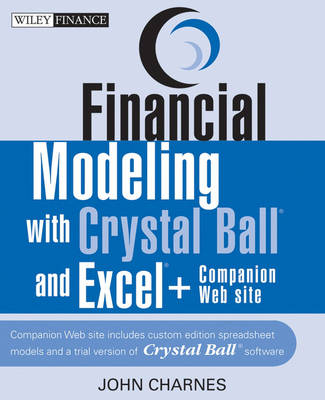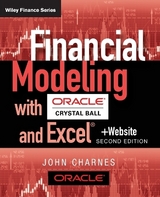
Financial Modeling with Crystal Ball and Excel
John Wiley & Sons Inc (Verlag)
978-0-471-77972-8 (ISBN)
- Titel erscheint in neuer Auflage
- Artikel merken
-Aaron Brown, Executive Director, Morgan Stanley, author of The Poker Face of Wall Street "Using Crystal Ball and Excel, John Charnes takes you step by step, demonstrating a conceptual framework that turns static Excel data and financial models into true risk models. I am astonished by the clarity of the text and the hands-on, step-by-step examples using Crystal Ball and Excel; Professor Charnes is a masterful teacher, and this is an absolute gem of a book for the new generation of analyst." -Brian Watt, Chief Operating Officer, GECC, Inc. "Financial Modeling with Crystal Ball and Excel is a comprehensive, well-written guide to one of the most useful analysis tools available to professional risk managers and quantitative analysts. This is a must-have book for anyone using Crystal Ball, and anyone wanting an overview of basic risk management concepts." -Paul Dietz, Manager, Quantitative Analysis, Westar Energy "John Charnes presents an insightful exploration of techniques for analysis and understanding of risk and uncertainty in business cases.
By application of real options theory and Monte Carlo simulation to planning, doors are opened to analysis of what used to be impossible, such as modeling the value today of future project choices." -Bruce Wallace, Nortel
Dr. John Charnes, PhD, MBA, is Professor, Scupin Faculty Fellow, and former director of the finance, economics, and decision sciences area in the University of Kansas School of Business. His specialty is the application of computer simulation and statistical methods for identifying and solving business problems, and his most current research involves using simulation for option pricing and hedging with derivatives to comply with Financial Accounting Standard (FAS) 133. Charnes has also performed research, consulting, and executive education for more than fifty corporations and other organizations.
Preface. Acknowledgments. About the Author. Chapter 1: Introduction. Financial Modeling. Risk Analysis. Monte Carlo Simulation. Risk Management. Benefits and Limitations of Using Crystal Ball. Chapter 2: Analyzing Crystal Ball Forecasts. Simulating A 50-50 Portfolio. Varying the Allocations. Presenting the Results. Chapter 3: Building a Crystal Ball Model. Simulation Modeling Process. Defining Crystal Ball Assumptions. Running Crystal Ball. Sources of Error. Controlling Model Error. Chapter 4: Selecting Crystal Ball Assumptions. Crystal Ball's Basic Distributions. Using Historical Data to Choose Distributions. Specifying Correlations. Chapter 5: Using Decision Variables. Defining Decision Variables. Decision Table with One Decision Variable. Decision Table with Two Decision Variables. Using OptQuest. Chapter 6: Selecting Run Preferences. Trials. Sampling. Speed. Options. Statistics. Chapter 7: Net Present Value and Internal Rate of Return. Deterministic NPV and IRR. Simulating NPV and IRR. Capital Budgeting. Customer Net Present Value. Chapter 8: Modeling Financial Statements. Deterministic Model. Tornado Chart and Sensitivity Analysis. Crystal Ball Sensitivity Chart. Conclusion. Chapter 9: Portfolio Models. Single-Period Crystal Ball Model. Single-Period Analytical Solution. Multiperiod Crystal Ball Model. Chapter 10: Value at Risk. VaR. Shortcomings of VaR. CVaR. Chapter 11: Simulating Financial Time Series. White Noise. Random Walk. Autocorrelation. Additive Random Walk with Drift. Multiplicative Random Walk Model. Geometric Brownian Motion Model. Mean-Reverting Model. Chapter 12: Financial Options. Types of Options. Risk-Neutral Pricing and the Black-Scholes Model. Portfolio Insurance. American Option Pricing. Exotic Option Pricing. Bull Spread. Principal-Protected Instrument. Chapter 13: Real Options. Financial Options and Real Options. Applications of ROA. Black-Scholes Real Options Insights. ROV Tool. Summary. Appendix A: Crystal Ball's Probability Distributions. Appendix B: Generating Assumption Values. Appendix C: Variance Reduction Techniques. Appendix D: About the Download. Glossary. References. Index.
| Erscheint lt. Verlag | 17.4.2007 |
|---|---|
| Reihe/Serie | Wiley Finance Editions |
| Zusatzinfo | Illustrations |
| Verlagsort | New York |
| Sprache | englisch |
| Maße | 191 x 234 mm |
| Gewicht | 512 g |
| Einbandart | Paperback |
| Themenwelt | Sachbuch/Ratgeber ► Beruf / Finanzen / Recht / Wirtschaft ► Geld / Bank / Börse |
| Informatik ► Grafik / Design ► Digitale Bildverarbeitung | |
| Wirtschaft ► Betriebswirtschaft / Management ► Finanzierung | |
| ISBN-10 | 0-471-77972-5 / 0471779725 |
| ISBN-13 | 978-0-471-77972-8 / 9780471779728 |
| Zustand | Neuware |
| Informationen gemäß Produktsicherheitsverordnung (GPSR) | |
| Haben Sie eine Frage zum Produkt? |
aus dem Bereich



